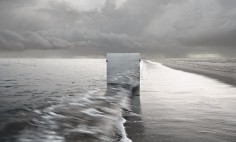SEOKMIN KO
the square
source: escoladeimagem
Em sua série de fotos “The Square” (O quadrado), o artista coreano Ko Seokmin lança uma pequena falha na realidade. Em cada foto, alguém pode ser visto segurando um espelho que obscurece tudo, menos suas mãos em volta das bordas, em alguns casos, misturando-os tão bem ao ambiente que é difícil ver onde estão.
A série é sobre camuflagem, tanto no sentido simbólico quanto no literal. O literal é o óbvio: o espelho está escondendo um original ou refletindo seu entorno. Simbolicamente, no entanto, a ideia é representar a pressão que vivemos, muitas vezes nos vemos na tentativa de refletir o ambiente utilizando a melhor de nossas habilidades.
Isso deixa apenas uma “imagem distorcida”, a única prova de que um indivíduo existe por trás da reflexão é que pequeno dedo aparecendo ao redor da borda do espelho:
Outra maneira de interpretar a obra é a descrita pela galeria Art Projects International, onde Ko está hospedando sua primeira exposição individual nos EUA
“A padronização refletida no espelho nunca é perfeita, estas obras não são sobre enganar o espectador. Nas imagens de Ko, o ser humano é uma espécie de ser discrepante que não pertence nem no mundo natural nem no mundo construído.”
Independente da forma que resolver interpretar a obra, as imagens são muito interessantes de se ver. Para ver mais sobre o trabalho do fotógrafo, visite seu site.
.
.
.
.
.
.
source: beautifuldecay
The Square is a series of photographs by Korean artist Seokmin Ko. Someone in each photograph can be found holding a mirror toward the camera. Given, the mirror is more easily found in some photographs than others. Still, the mirror in somewhat hides the person holding it, the reflection blending in with the background. This is essentially a camouflage that works by imitating its surroundings. Ko alludes to this in his statement, and draws similarities to social situations. Peer pressure for conformity and social norms compel people to use such a social camouflage. That is to adopt behavior that mimics surrounding groups in order to hide a person’s individuality. Still, fingers peek from behind the mirror – perhaps an allusion to the persistence of individuality.
Of course there are several ways to read Seokmin Ko’s work. Like a mirror it reflects interpretations singular to each viewer. Ko’s most recent solo exhibition illustrates this. Interestingly the curater presents an entirely different approach to the series. In part, the gallery statement brings out:
“Ko is an artist of his own time. The mirrors and reflective glass make more sense as portals to other dimensions—dimensions perhaps similar to ours or radically different. The patterning reflected in the mirror is never a seamless match with the mirror’s immediate surroundings; these works are not about tricking the viewer. In Ko’s images, the human, as the carrier of artifice, is a kind of discrepancy and belongs neither in the natural world nor in the constructed world. This is obvious in the architectural photographs where the human presence disrupts the dehumanizing machine-made grid. Ko’s is a humanist vision amidst a world that has become foreign to its inhabitants as creators, but as Einstein famously said, “In the middle of difficulty lies opportunity.” Ko’s disruptions offer hope.”
.
.
.
.
.
.
source: switchie5wordpress
Seokmin Ko est un artiste coréen de 19 ans qui vit à Séoul. Dans sa série d’auto-photos intitulée The Square l’artiste insaisissable disparait derrière des miroirs géants carrés qui reflètent l’environnement tout en le dissimulant lui…
.
.
.
.
.
.
.
source: kulturauz
Фотограф поясняет, что зеркало – это аллегория современного общества, в котором люди стараются задавить друг в друге индивидуальность, осуждая оригинальность, искренность, непохожесть на других. Seokmin Ko так комментирует свой проект: «Мы живем, закрывшись друг от друга. Устои, обычаи, традиции – все это «стандартизирует» человека, общество воспитывает людей, лишенных своего собственного «я». Чтобы стать «нормальным» человеком, мы начинаем меняться, и в этом состоит главная трагедия».


